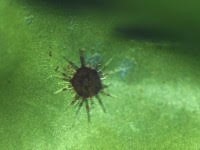Breeding of Paracentrotus lividus at the MaRe Facility of Zoological Station
 The common sea urchin, Paracentrotus lividus, was among the first marine organisms used for research purposes, for instance in embryology. Over the last twenty years its use in science has expanded greatly. In fact, it has become a model organism in such research fields as cell biology, evolutionary developmental biology (Evo-Devo) and ecotoxology. One of the main reasons why this species is so popular among scientists is that developmental stages (from fertilization to the adult sea urchin) can be observed in a simple and easy way.
The common sea urchin, Paracentrotus lividus, was among the first marine organisms used for research purposes, for instance in embryology. Over the last twenty years its use in science has expanded greatly. In fact, it has become a model organism in such research fields as cell biology, evolutionary developmental biology (Evo-Devo) and ecotoxology. One of the main reasons why this species is so popular among scientists is that developmental stages (from fertilization to the adult sea urchin) can be observed in a simple and easy way.
However, a limitation for the use of animal models, including the sea urchin, is linked to the seasonality of the reproductive cycle. Gametes are unavailable outside the breeding season.
Paracentrotus lividus is not only an important model species for science; its gonads are considered also a culinary delicacy by many people, hence the strong decline of its stocks along the Mediterranean coasts. Nowadays, the species is inserted in Appendix 3 of the SPAMI Protocol, and in Italy its fishery is strictly regulated by D.M. of 01/12/95.
Therefore, there is a strong need to control the maintenance and breeding of this species year-round under controlled conditions in the laboratory and on a commercial scale, in aquaculture. This way, the harvesting pressure on natural populations can be expected to diminish whilst new economic activities and jobs are created.
At the MaRe Unit of the Stazione Zoologica Anton Dohrn breeding attempts of P. lividus have been successful and juvenile sea urchins are now growing. Experimental diets are tested and their effect on growth monitored. The next step will be to transfer the young sea urchins from the nurseries at the MaRe facilities to the sea, where their development to the adult stage will be completed.
For the research it is crucial to have adult specimens available in a fertile state all year round. Therefore, we test experimental diets and verify gonadal growth and quality of produced gametes.










